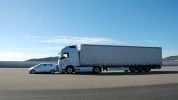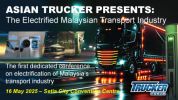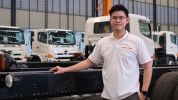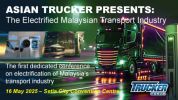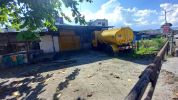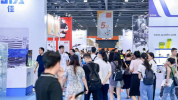Giovanni Siano, an independent consultant and a representative for a European manufacturer of specialised components, reviews the development of Thailand’s assembly and manufacture of specialised vehicles and the threats the industry powerhouse now faces.
Thailand is one of the most active countries in S.E. Asia in assembling a wide variety of specialised vehicles for its domestic market, but also for export to neighbouring Asian countries, the Indian Subcontinent and even the Middle East and Africa.
Bidding for Work
As in most Asian countries, until the 1980s the supply of specialised vehicles relied mostly on imported built-up units from overseas. The most common purchasing system has been (and still is) by means of local or international tenders issued by the competent authorities, both in the civilian field as well as by the police and army.
Unlike Europe, USA and Australia, where an extensive number of private operators in different sectors have their own fleets of specialised vehicles, in most Asian countries the great majority of public and municipal services are carried out by the government while private operators bid for jobs as sub-contractors. In recent years there has been a growing trend to privatise services, especially in health care and the environment.
Local Production
Specifically in Thailand, up to the mid 80s, very few companies had joint ventures with specialist firms from oversea in the manufacturing of garbage compactors and road tankers for fuel, nor with a well-know European manufacturer of fire trucks and specialised trailers. After that, local industries started developing, and gradually integrating, fully imported special vehicles from overseas with local built ones.
At first, fleet managers had to rely on their own inventiveness and entrepreneurial spirit in trying to find the most suitable technical solution. Only a few firms enjoyed the required know-how transfer or joint venture with oversea companies. In most cases, it was about gathering the needed crucial imported components (hydraulics, gears, pumps, cranes, platforms, etc..) and building up the best possible vehicle by using locally assembled truck chassis. The adaptation of foreign designs to local habits and practicality played an important role.
Crucial Components Only
Already penalised by heavy import duties, and with the rise of the local manufacturing, the import of complete built-up vehicles slowed down dramatically resulting in only the import of the crucial components, which has become the norm throughout Asia. In some cases, truck body builders import the complete special superstructure and mount it on locally available truck chassis.
The government of the Kingdom of Thailand has dealt, on a number of occasions, with government-to-government contract aids and special economic transactions that are favoured by particular banking deals. Some foreign countries financed, at very low interest rates, the purchase of a large number of specialised trucks, particularly emergency and military vehicles. It is therefore common to spot imported vehicles in the streets of Thai cities.
Apart from these cases, the bulk of special vehicles in Thailand are fully local manufactured; from garbage compactors to water tankers, trailers to cement carriers, from fire trucks to fuel tankers and all other types you can think of!
Meeting Local Needs
A number of specialised assemblers provide a strong supply of vehicles to meet local needs and in some cases also for export. Among the companies that have contributed to this Thailand success are: Chase Enterprise (emergency and rescue vehicles), Cosmo Trucks (very wide range of specialised vehicles), CTV-Dollasien (Airport logistic trucks and other specialised units), Panus Trailers (trailers, cars carriers, tankers), Sammitr Motors (construction dumpers platforms, tankers, compactors). These are all companies with large order portfolios, but an equally important number of small and medium companies provide backup for minor orders, repairs and small customisations, at times cooperating with the larger groups.
Thailand is a powerhouse in the auto industry where a massive quantity of trucks and car components are being manufactured and exported all over the world, including for American and Japanese producers. The four Japanese truck manufacturers: Hino, Mitsubishi, Isuzu and Nissan, have assembly plants in Thailand. Volvo and Scania assemble a selected number of series/models, so the availability of chassis is higher than in neighbouring countries giving an edge to local assemblers in model choices, at least for right hand drive models.
China Enters the Scene
The Thai market is loyal to the four Japanese and the European brands. Recently a relatively small number of Chinese made trucks have started entering the market, but unlike some neighbouring countries, the presence is still rather limited, but according to many is on the rise. This is inevitable as Chinese producers of truck chassis now rank as top world manufacturers of heavy commercial vehicles having, in 2010, surpassed European and American companies with well over 30% of worldwide production.
Local assemblers have to gain a competitive edge considering that most jobs are government tenders with the lowest price winning the bid. It is important to keep a balance between quality and competitive prices since reputation and trust are very important issues in Thailand. This is a crucial point that will determine which companies will do better than others, and receiving a due appreciation in term of quality and reliability in the long term.
Chinese Special Vehicles
Along with the growth of production of truck chassis in China, a new threat is coming for Thai bodybuilders from the importation of Chinese made complete built up special vehicles. For example, a number of suction road sweepers have already been imported into the Kingdom with mixed opinion about their quality, but their low price provides an advantage. Other SE Asian countries are already importing a good number of Chinese made specialised trucks and trailers.
Innovative engineering and the use of quality-imported components and materials whenever what is available locally cannot cope with the requirements, coupled with updated manufacturing methods, will be a winning factor. Cheap labour is no longer a key factor to survive in this competitive environment with new players appearing and eager to take a part of the business.
